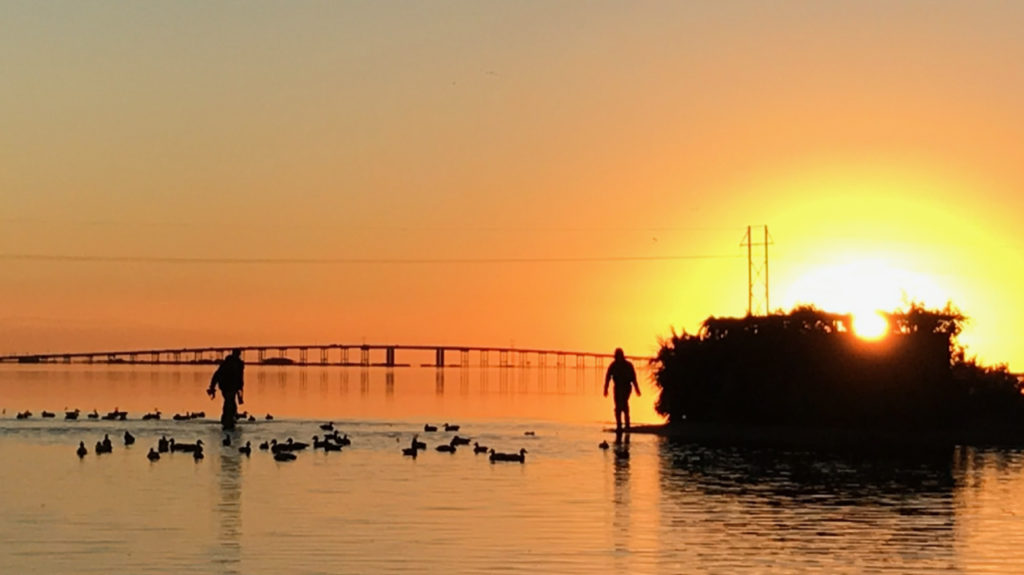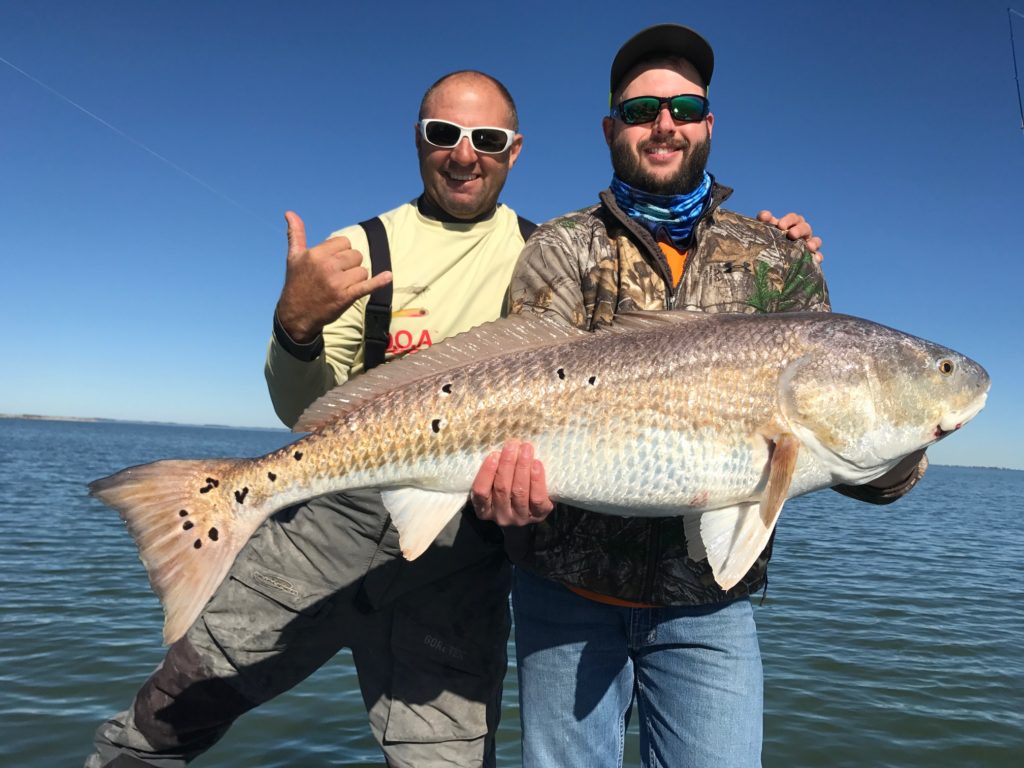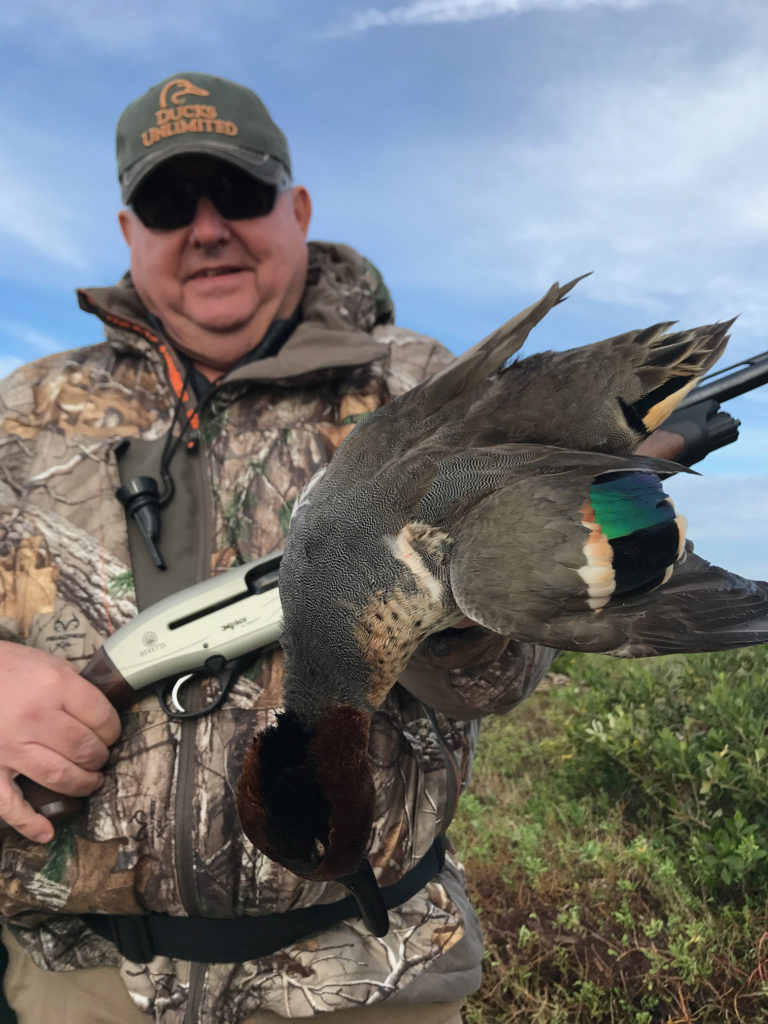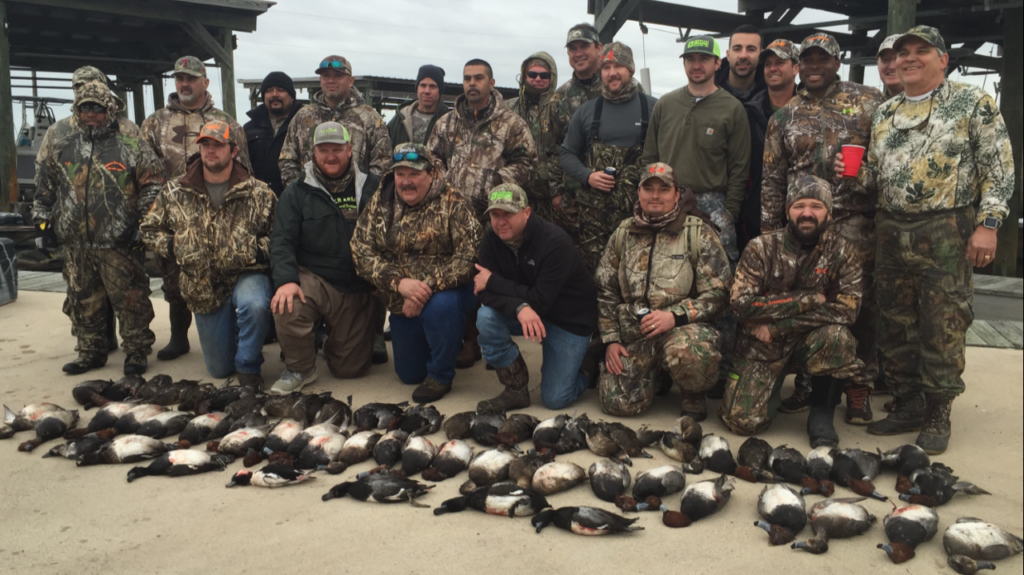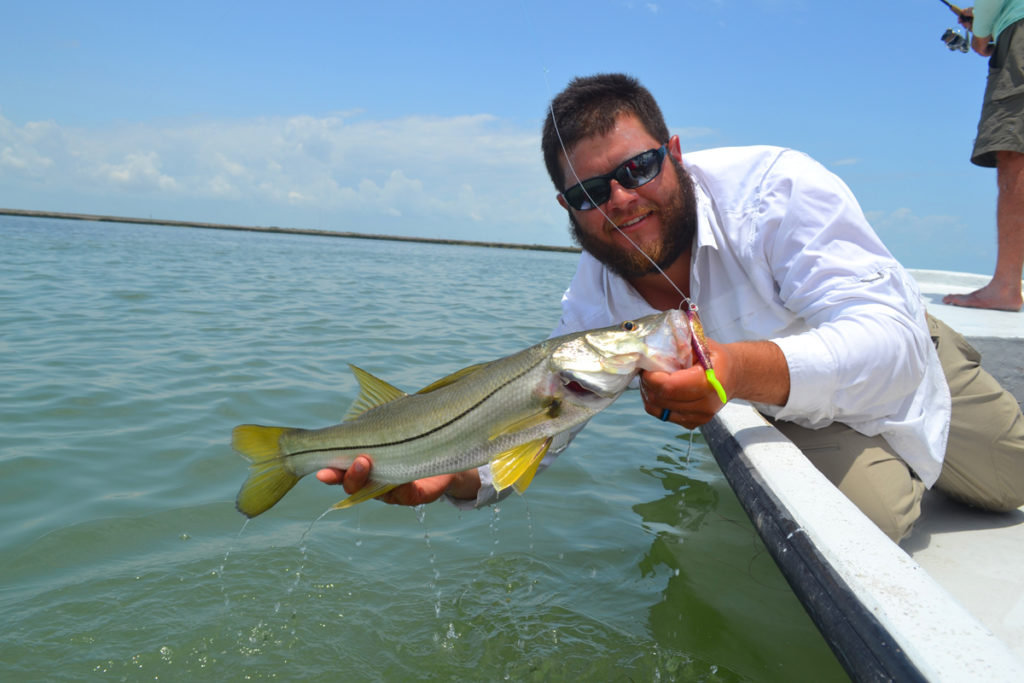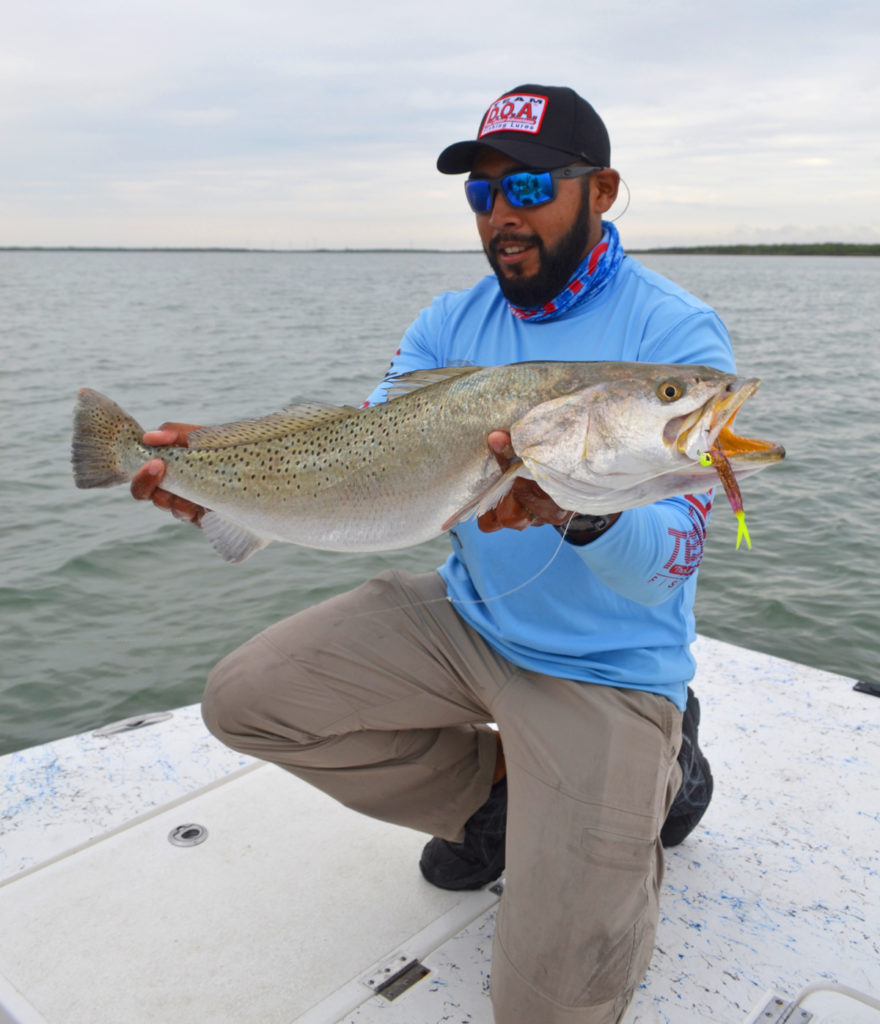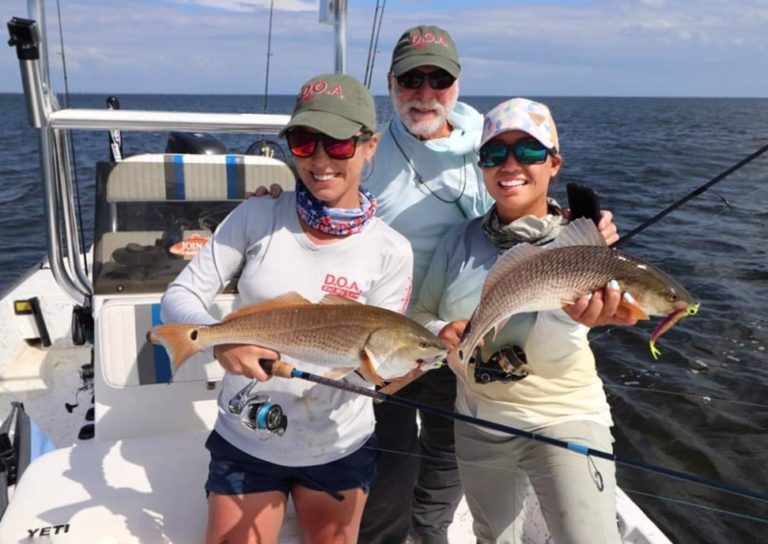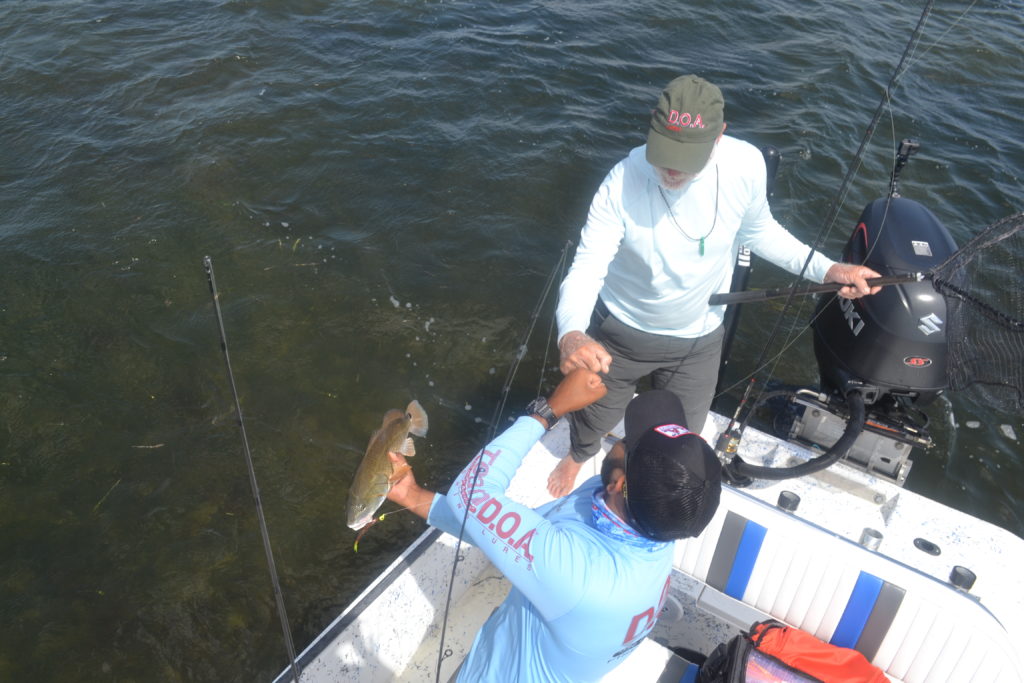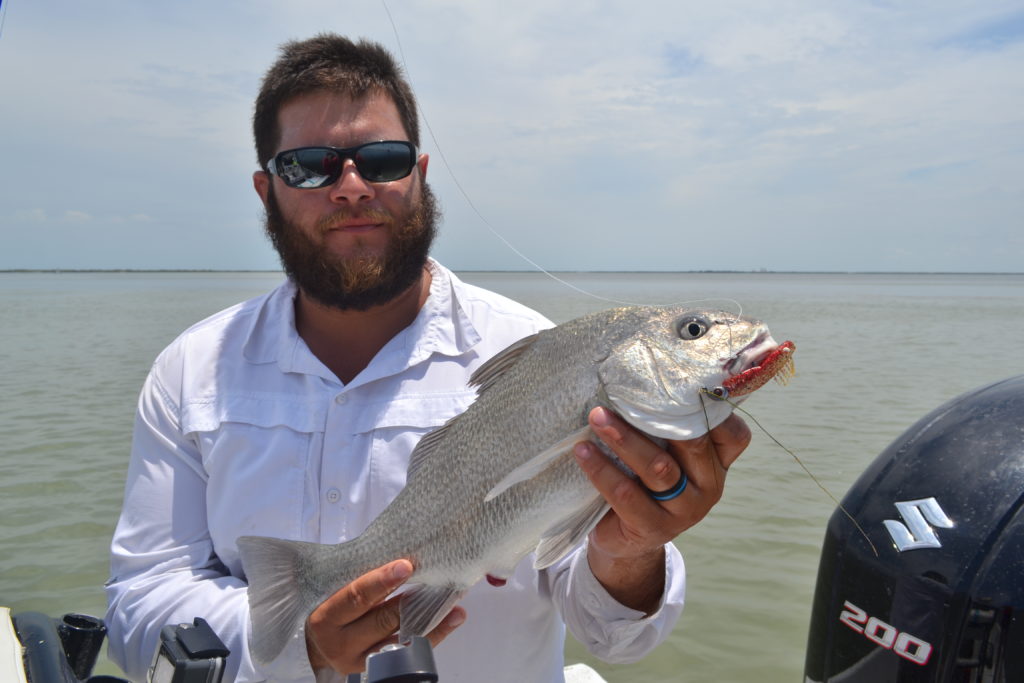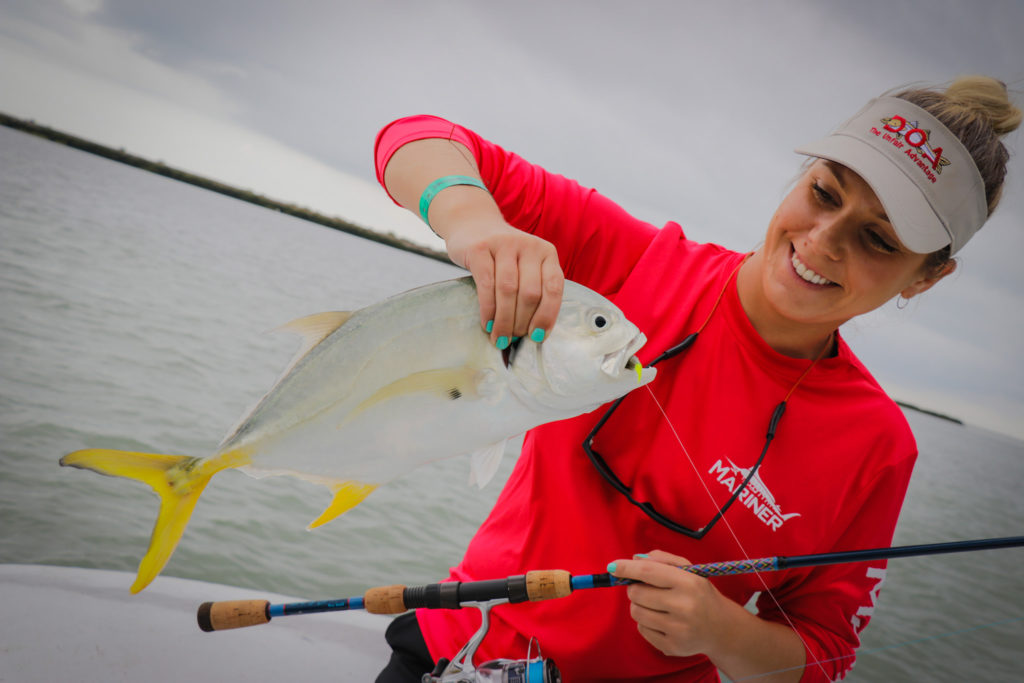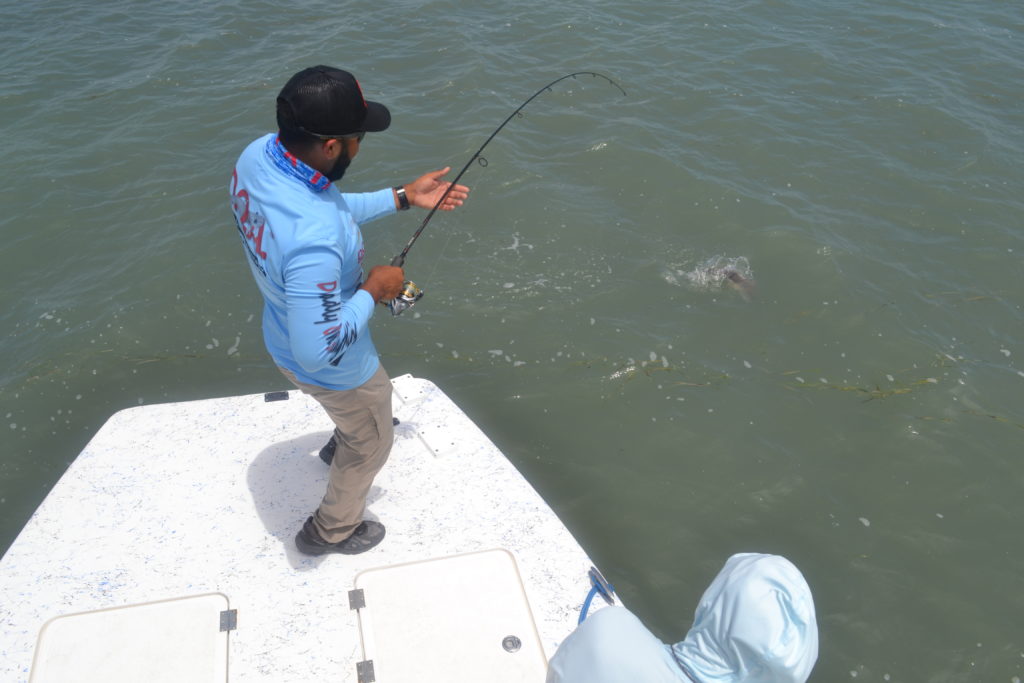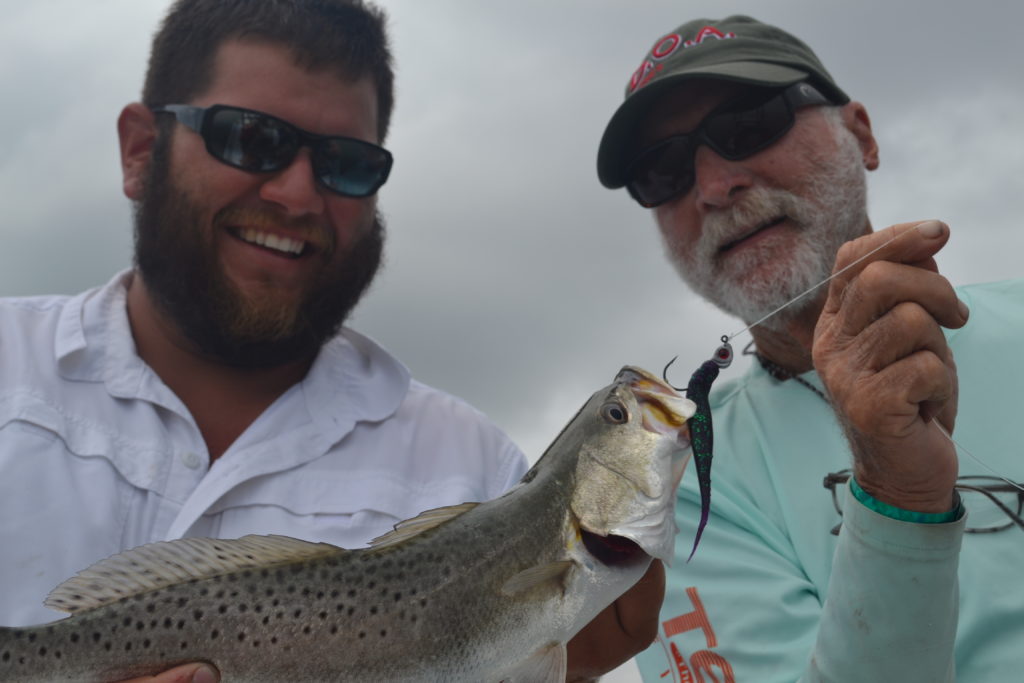
Capt. Clay Sheward holds up a nice marsh redfish with a double spot tail.
Story and photography by Brandon Rowan
THE WATER IS STILL AND SO AM I. The redfish swims along a flat, that is painted with a palette of green sea grass and dull colored sand, unaware of our presence. On the bow of Capt. Clay Sheward’s skiff, I feel more like a hunter in a tree rather than a fisherman. The rod in my hand is the bow and the arrow is a hair-tied Buggs jig at the end of my line.
Clay gives the word and I make a light cast behind and ahead of the red. We can see everything in the water on this calm October morning. I reel quickly to intercept the moving fish and begin jigging to tempt what I hope is a hungry fish. My heart starts beating faster as the redfish inches closer and closer to my offering. Time thickens and that half moment seems to last an eternity before the fish inhales the Buggs lure.
♦
BEGINNINGS
Clay Sheward, 37, was born and raised in Spring, Texas. His passion for fly fishing started very early in life.
“I’ve been fly fishing for a really long time, since 1992, when the movie A River Runs Through It came out,” Clay said. “I saw that movie with my dad and that Christmas, my family provided me a fly tying kit and a fly rod.”
The film is set in early 20th century Montana and follows a pair of brothers and their love of fly fishing. Many scenes in this movie do an excellent job of capturing the camaraderie of fishing; the tense moments before the catch and the euphoria after the fact. It won an Academy Award for Best Cinematography in 1993.
Clay cut his teeth fly fishing on the local ponds and creeks near the Woodlands, but as he grew older his love of fly fishing carried him to new locations.
“Mostly, I went to the Guadalupe and the White River in Arkansas. Sometimes my family would travel to Colorado. I didn’t get to do it a whole bunch but I would practice casting in the yard to teacups. Of course, I grew up and girls came along, but I always tied flies. I still do it regularly,” Clay said.

OCEAN CALLING
Eight years ago, Clay’s focus shifted from freshwater to saltwater fly fishing. First from a kayak, then to an Ankona ShadowCast 18 which served him and his customers well for several years. But in 2019, Clay was searching for his perfect skiff and finally found it.
“I run a 2019 Chittum Skiffs Laguna Madre with a 50HP Tohatsu. I couldn’t be happier. The trailer is gorgeous and it is such a really nice rig. I can’t believe that I have one. It’s just unbelievable,” Clay said.
The Chittum has expanded Clay’s range and clients of Buggy Whippin Sight Fishing enjoy access to the skinniest of waters in our area.
 STUDENT OF NATURE
STUDENT OF NATURE
Clay’s love and careful examination of nature has paid dividends on the flats, where subtle, easily overlooked signs can tip off the location of fish.
“I like to watch animals. It doesn’t matter if it’s just me chilling in the backyard watching birds or hawks, or even seeing my dogs’ ears perk up when they catch a scent and chase it down,” Clay said. “Sitting stream-side, watching a trout circle behind a rock and then leave during changing cloud cover and then come back to the same spot several times a day. Or watching a spider build a web completely from start to finish. That sort of thing.”
Clay recently purchased a drone to better observe wildlife in the marsh. This eye in the sky lends a totally different point of view compared to a poling skiff.
“I’ve seen some crazy things with trout and redfish schooling up on the flats with the drone,” Clay said. “I’ve seen schools of redfish following one big alligator gar. Whatever the gar did, the redfish did the same. I’ve seen bobcats back there in Green’s Lake, as well as pigs. It’s educational as hell.”
♦

Brandon Rowan with one of many redfish caught sight casting with Capt. Sheward.
TIME RETURNS TO NORMAL and I quickly bring my first sight-casted redfish to hand. I get a “nice job” and a fist bump from Clay after the release. The day is early and we continue our hunt for redfish along the sandy flat.
Stingrays, so many stingrays, hover along eeriely as we the glide down the shoreline. Flounder scoot away in a trail of punctuated mud puffs and gnarled, large crabs plod on slowly. This is my first time on a poling skiff and it 100% reminds me of flounder gigging. You are able to witness the abundant life of the bay, visually scanning until your target is located and then a careful approach begins. Unlike the rapid fire retrieves of blind fan casting, you often only get a single shot, like a sniper, when sight casting to a redfish.
Further down the flat, we have no problem tracking down more reds on this absolutely gorgeous day. Bronze backs and tails flick along the shorelines and shell points. Some of these we catch, others refuse the lure or fly, and others spook and run.
It felt like an entire day’s worth of fishing has happened but in reality only two hours have passed. But the day is young. We make a change, push off the flats and head back into the deeper recesses of the marsh.

This redfish absolutely crushed a Buggs Jig.
BUGGY WHIPPIN
Clients of Capt. Clay Sheward can expect to fish the maze of marshes and flats on the north shoreline of West Bay and the surrounding areas. There are opportunities to wade or even fish from shore. His Chittum Laguna Madre skiff has everything the fly angler could want and accommodates two fisherman.
However, you don’t need to know how to fly fish to enjoy sight casting for redfish. Catching these fish on light spinning tackle is still a blast and provides ample challenge. You will be thoroughly tested on how accurately and quickly you can place a cast.
“Scratch them on the chin” is what Clay advises when casting to a hungry redfish. It’s hard for them to resist an easy meal in front of their noses. An alternative method is to cast beyond and ahead of a fish, making sure you intercept its path.
No matter your tackle, stealth and speed are essential for success. Casts must be made quickly but delicately, without excessive movement. Heavy steps, twisting hips or any careless motion can rock the skiff and alert fish to your presence.
Clay does not sugar coat it. If you are doing something wrong, he will absolutely let you know. But the best teachers rarely coddle. Those ready to learn and listen have a high probability for an epic day of redfishing with Captain Clay Sheward.

Capt. Clay Sheward poles his Chittum Skiffs Laguna Madre along the flats.
KEEPING IT FLY
As a fledgling fly fisherman, I was eager to pick Clay’s brain on advice for those new to the sport.
“First, remember ‘tip down, strip tight and everything will be alright,’” Clay said. “Second, if you feel like you need to go faster and harder, you probably need to go slower and softer, especially with a fly rod.”
Must-have flies include the kwan, clouser, gurgler, spoon fly and any shrimp imitation with a weed guard. If Clay could only have one it would be the kwan. He also recommends tying a loop knot, with as small a loop as possible, for most flies. He is an avid user of 16 and 20 lb tippets for his clients when targeting redfish on the upper coast. He is also a firm believer in casting whichever rod you are going to buy.
“Cast it and get what feels good to you. Redfish don’t need expensive fly reels. It’s nice to have, but not needed for reds in our area,” Clay said. “Gordy and Sons is one of the nicest fly shops in Houston. They’re no joke and the people that work there are extremely knowledgeable fly anglers.”
Although Clay’s all-time favorite fishing location is the Black Hills of South Dakota, his favorite fish to catch on the fly is the tripletail.
“Getting them to eat is the best because they are so stingy man! It’s got to be a perfect presentation,” Clay said. “You can get really close to them though and that gets the nerves going. I think that’s my favorite right now, but chasing a redfish with its back out of the water, and poling up to them…hunting them, that’s always going to be for me.”
♦
THE SUN IS OUT NOW and we find ourselves deep in the marsh, floating along a back creek that is absolutely full of redfish. We glide over schools of erratic, frenzied bait as multiple big redfish cruise down the shoreline, picking them off lazily, one by one.

Clay’s oversized redfish.
It’s been several hours since we left the dock and I’ve honed in on what’s needed to effectively spot and cast to fish, thanks to Clay’s instruction.
We absolutely tore it up on that little stretch of water. After each fish caught and released, we seemed to spot another one right away. Clay caught an absolute beauty of a fish that taped out barely over 28 inches; a heartbreaker of a fish if it was a tournament day.
My favorite catch of the day was an upper slot redfish that came on a second chance. We had a pair of fish swim across our path that ignored the first presentation. They picked up speed and starting swimming away, no longer in sight. I flung out a far cast, as delicately as I could, and started jigging back to where I thought they might be. I knew I got it right when my reel’s drag started screeching. After a rigorous fight, I brought the bronzed backed, pumpkin eyed fish in for a quick photo and release.
It was early in the afternoon but we decided to end the day on high note. The Chittum snaked its way through the marsh lanes as we made the scenic trek back to the dock. I was definitely impressed with the way the boat handled. It took on chop with no issue, didn’t slide around the corners and granted us access to areas other poling skiffs couldn’t reach that day.
I’ve caught my fair share of redfish and I’ve got to say this was the absolute, most exciting way to catch them. If you have a background in kayaking, gigging or hunting, and you haven’t sight casted to redfish, you are missing out I’d say.
Summer and fall are Clay Sheward’s favorite times to be on the water but winter does have its perks.
“The water is so clear in the winter and it’s so fun. You can see everything on the bottom when you’re poling. You can learn so much, it’s incredible.”
Book a trip with Capt. Clay Sheward by visting buggywhippin.com, emailing claysheward@gmail.com or calling/texting 281-745-1578. Rates for two people max are 4 hours at $450, 6 hours at $550 and 8 hours at $650. Check him out on Instagram and Facebook @BuggyWhippin

Check out the heart shaped spot on Clay’s redfish!




 STUDENT OF NATURE
STUDENT OF NATURE













 What a difference color can make!
What a difference color can make! Saltwater fish living where the water is very clear tend to be bluish or silver.
Saltwater fish living where the water is very clear tend to be bluish or silver. The reason for this change is to camouflage and protect them from predator fish.
The reason for this change is to camouflage and protect them from predator fish.



























